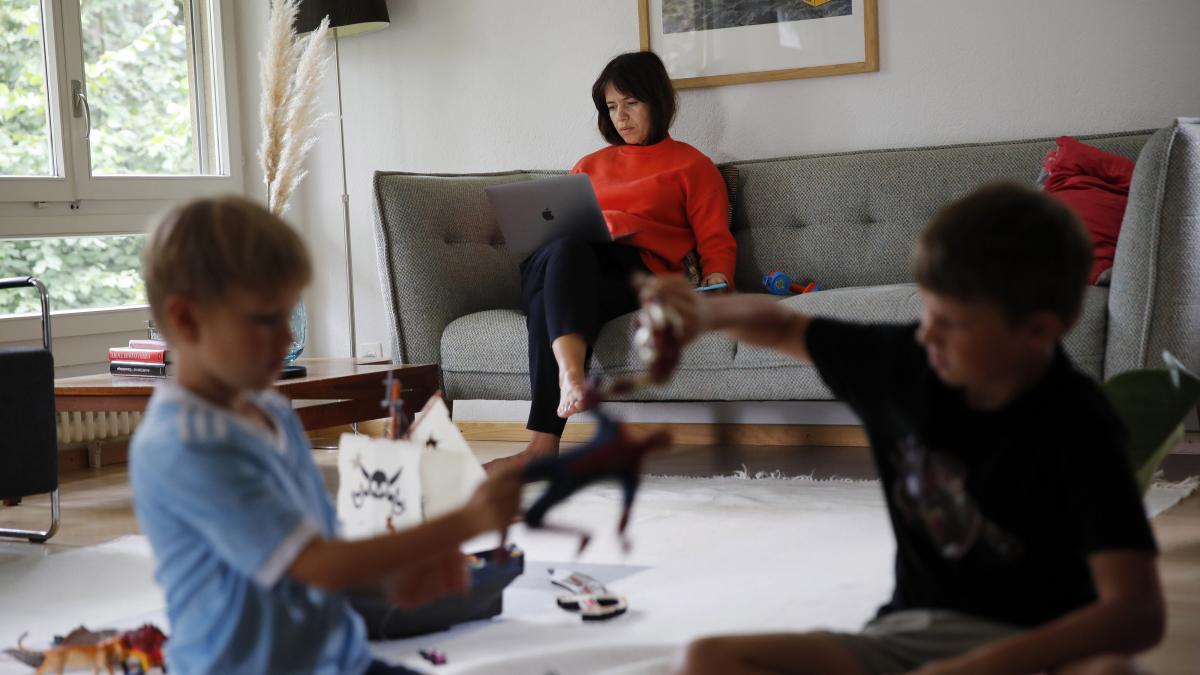The socioeconomic effects of COVID-19 on women
The pandemic has disproportionately affected women both professionally and at home. Although the gender gap in labour force participation since the on

Following widespread vaccination campaigns, European economies are beginning to emerge from the depths of the recession caused by the COVID-19 pandemic. As billions are spent to accelerate the recovery and stabilise economic growth, it is important to highlight that not all members of society are emerging from this crisis in the same way and to understand why. The COVID-19 pandemic affected women significantly differently from men in many dimensions. Pre-existing deep rooted gender inequalities have been exacerbated so much that this pandemic has been referred to as a step backwards for gender equality.
The COVID-19 pandemic was different insofar as it flipped the usual effect of recessions on the workforce on its head. In cyclical economic downturns, male workers tend to be more strongly affected because they work predominantly in sectors that are more dependent on the business cycle, such as manufacturing and construction. The pandemic, in contrast, affected a different set of industries than usual recessions, in particular those in which women represent a larger share of the workforce. Women represent the majority of workers in frontline services such as health, long-term care or education, which exposed them to a high risk of infection. Women make up the majority of employees in industries hit hardest by lockdown and containment measures, including retail, food services, accommodation and personal services like hairdressers (Figure 1). This, in turn, placed them at an increased risk of job loss and precarious employment.
Figure 2 plots the correlation between female employment shares in occupations and an occupational social interaction score. Women in the European Union are disproportionately employed in occupations that require a lot of social interaction. They represent 82% of health professionals and 80% of teaching professionals. Over two thirds of personal services workers are women, as are almost three in four sales workers.
At the EU level, the female unemployment rate increased slightly more than male unemployment during the first wave of the pandemic, rising from 6.9% to 7.9% from the first to the third quarter of 2020, compared an increase for men of 6.4% to 7% during the same period. Following another peak in the first quarter of 2021, female and male unemployment rates recovered to 7.3% and 6.6%, respectively. The loss of jobs was particularly pronounced among women with low levels of education, who even before the onset of the crisis faced higher levels of unemployment than men with the same level of educational attainment. The same pattern, albeit smaller in magnitude, applies for women with upper secondary education (Figure 3).
Women, who on average earn less than men and have accumulated less wealth than men are more likely to face financial difficulties following a sudden loss of income. The financial resilience of European households was already worrisome before the onset of the pandemic, with one in three EU households unable to face an unexpected financial shock. That number rises to 57% when considering single parent households, the majority of which are women. Levels of financial fragility, defined as the inability to finance an unexpected expense such as a funeral or the replacement of a washing machine, among single parent-households remained high during the pandemic but changes at the country level relative to pre-pandemic levels are mixed (Figure 4). While the rate grew significantly in Romania, Bulgaria, Lithuania, Slovakia, Greece and Malta, it also declined strongly in the Czech Republic, the Netherlands and Finland, and even more so in Estonia, Portugal and Croatia. Changes in other countries were moderate.
It is highly unusual for such significant improvements to materialise from one year to another. We believe, instead, that these improvements in the financial situation of single parents are likely due to the exceptional policy response to the pandemic, in which many countries provided financial support to particularly affected groups. While this is an encouraging development, in this context it will be crucial to monitor how financial fragility levels develop when support is withdrawn.
Previous Bruegel research documents a significantly higher level of financial fragility among single women than single men in all EU countries except for Finland before the pandemic. Figure 5 shows the different financial fragility rates for single female and male households during the pandemic in 2020 where data is available, which confirms that women are still disproportionally affected by financial risks in the EU. Women remain more financially fragile than men in all but two countries: Denmark and the Netherlands. Sweden, Belgium and France also appear to offer an almost equal playing field. In contrast a worryingly sizable gender gap is present in eight EU member states: financial fragility affects over 10% more women than men in Bulgaria, Hungary, Slovenia, Portugal, Greece, Slovakia, Cyprus and the Czech Republic.
Figure 6 depicts how the pandemic affected this gender gap, by comparing the gender gap from 2020 with that of 2019. Inequality deteriorated during the pandemic in 11 out of the 21 reporting countries, in particular in Croatia, Bulgaria and Portugal, where the financial fragility gender gap widened by 6%, 4.9% and 3.8% respectively. Conversely, the gender gap diminished in 10 countries, in particular in France and Slovenia.
Job leaver statistics indicate that women left their jobs at higher rates than men during the pandemic. Job leavers are all people who left their jobs in the previous three months, be it due to dismissals, retirement or quitting. In the two years before the pandemic, women and men left their jobs at the same rate of around 2% of total employment at EU level. This rate increased more strongly and persistently for women than for men in 2020, peaking in 2020Q2, with significant variation across member states.
High female employment shares in close contact sectors and the ensuing rise in female unemployment are certainly drivers of this development. At the same time, owing to the closing of schools and childcare centres working parents had to balance (remote) work with caretaking responsibilities. Emerging evidence suggests that women bore the brunt of this additional load which led to a reduction in the female labour supply at the extensive and intensive margin.
A US survey by McKinsey found that a quarter of surveyed women considered leaving the workforce or downshifting their careers during the pandemic, compared to one fifth of men. When considering only parents of young children (<10 years), 23% of surveyed women considered leaving the workforce, 10 percentage points more than men.
A number of studies has investigated the time-use patterns of heterosexual couples with children during the first wave of the pandemic in the US, the UK, Germany, Italy and Spain. While both fathers and mothers increased their engagement in unpaid work at home, all studies found a manifestation of traditional gender roles, with women taking over the majority of additional housework and caretaking responsibilities. Importantly, these results could not simply be explained by gender differences in work status or remote work opportunities. Mothers were found to reduce their paid work hours more strongly than fathers to accommodate increased childcare demands, and spent more time simultaneously working and looking after their children. Women also interrupted their paid work more frequently to handle housework demands and as a result fathers had around twice as many uninterrupted work hours than mothers in the UK. Finally, studies show that the additional burden of caretaking and housework, and the inequal allocation of those tasks led to a deterioration of subjective well-being of women.
It is likely that these situations affected the quality of work time and caused a reduction in productivity for workers, much more for women than for men. Task juggling and work interruptions have been found to lower productivity and potentially even negatively affect earnings. First evidence from the gender shares of authorship of academic publications during the pandemic suggests this may indeed have occurred. In biomedicine, women’s share in academic research output has fallen significantly since the onset of the pandemic. This effect was particularly pronounced in emerging research relating to the pandemic. The same was found in economics, where female publication shares remained constant for non-COVID related output, but dropped significantly for research on pandemic-related topics. This effect was particularly pronounced among early- and mid-career economists. Such productivity slumps may have implications for women’s future career prospects, by reducing their chances of promotion or pay raises, contributing to a growing gender wage gap and general worsening of work outcomes for women.
The implications of additional care and household burdens on women’s productivity, work hours and wellbeing as a result of the pandemic need to be addressed in order to prevent an exacerbation of gender inequalities in the labour market. Even though caretaking responsibilities have returned to near-normal levels, as schools and childcare facilities reopen, the long-term consequences of the pandemic on labour markets are only beginning to materialise. One example is the growing importance of remote work or hybrid work models.
A recent Eurofound survey found that women would prefer to work remotely more frequently than men, and this gap increased over the course of the pandemic. While in the summer of 2020, 43.6% of men said they would prefer to telework daily or several times a week, compared to 45.1% of women, the results from early in 2021 (Figure 8) show that this share increased for women to 49.1%, while it decreased slightly among men to 42.8%.
Evidence from before the pandemic suggests that teleworking can deteriorate career advancement opportunities, which may be a result of individual performance being less visible compared to that of colleagues that are working on location. Working from home can also exclude employees from informal networking opportunities with colleagues and supervisors, and eliminates the potential for spontaneous involvement in decision-making and project assignments. When these disadvantages disproportionately affect women, they could perpetuate existing difficulties of female workers to build relationships with their often-male superiors. As argued in a Bruegel policy contribution, unless the disadvantages created by selective teleworking are addressed, we will see gender inequalities deteriorate.
Policy recommendations
There is a significant risk of increasing divergences and persistence in the effects that we identify. Policymakers should monitor socioeconomic gender effects carefully as we recover from the crisis. This includes looking out for adverse consequences of the winding down of pandemic support programs, such as inequal increases in financial fragility or poverty rates. Policymakers should invest in financial literacy programs to improve people’s ability to manage their budgets before and during economic recessions. Financial literacy has been found to be an important element in reducing financial fragility and is lower among women then among men.
In addition, policymakers should shift their attention to unpaid care work. Investments in long-term and elderly care and expanding childcare availability for parents of young children will support especially women and allow them to allocate more time to effective, paid work. Reforming current parental leave legislation to establish paid paternity leave beyond two weeks throughout the EU would furthermore contribute to a more equitable sharing of care responsibilities between mothers and fathers.
More women lost their jobs during the pandemic. In particular women with low levels of education have not yet recovered fully from the unemployment shock of the crisis, and there is a risk that this larger gender unemployment gap will persist. At the same time, the crisis does not seem to have driven women out of the labour force at higher rates than men (Figure 9). According to the latest data, the gender gap in labour force participation has not worsened since the onset of the pandemic and even improved in a number of countries, which is good news for the economic recovery. Nonetheless, the gap remains substantial in many other countries, and low female labour force participation is a structural problem worth addressing.
In the future, there will be a permanent shift towards more remote working, which will be taken up at higher rates by women than men. Knowing that remote work can have adverse consequences for career opportunities and wages, policymakers should address the potential risks of deepening disadvantages for women in the workforce. This includes raising awareness for biased assessments of teleworking employees and carefully monitoring emerging trends and gender dimensions in labour market outcomes.
[1] The amounts are based on a search of the Bruegel database of EU countries' recovery and resilience plans using the terms Woman / Women / Female / Gender / Girl / Maternal / Maternity / Shelter / Violence / Parent / child / childcare / nursery / nurseries / kindergarten
The policy response so far to address the gendered impact of the pandemic has been limited. For example, only three countries dedicate any funds from their allotment of the Recovery and Resilience Facility (RRF) to initiatives specifically addressing gender inequalities. Austria, Belgium and Italy will invest a combined €878 million into women’s issues in the areas of health, social infrastructure and labour markets. Extending the filter to include funding dedicated to the support of working parents, such as on childcare and nurseries, the amount climbs to €6.8 billion which still only amounts to less than 1% of the RRF[1].
Next Generation EU is not purely a tool to stimulate economic recovery, but has the explicit purpose to set the EU economies on a more sustainable, digital and future-proof growth trajectory. This structural orientation makes it the right tool to use to prevent a perpetuation of existing obstacles to female labour market participation, advancement and outcomes. Although the explicit spending on gender equality measures is small, the impact of the remaining 99% of investment on women is as yet unknown, and we encourage the EU and its member states to conduct gender impact assessments of all initiatives to ensure investments contribute to a more equitable future for women and men.
Recommended citation:
Demertzis, M. and M. Hoffmann (2021) ‘The socioeconomic effects of COVID-19 on women’, Bruegel Blog, 3 November



